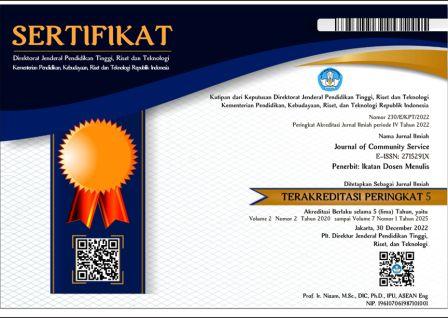Community-Driven Media Literacy And Resilience Building
A Case Study of Grassroots Efforts in Combating COVID-19 in Surabaya
Abstract
During the Covid-19 pandemic in Indonesia, social media and mainstream mass media have been flooded with viral content, challenging the dichotomy of acceptance and resistance to prevention programs. To create resilience, education-preventive efforts are needed to empower vulnerable communities. A community service program aims to educate the public about digital media dynamics and teach people to create content about preventing transmission and creating resilience. The program focuses on raising community awareness, particularly among young children, and demonstrates that people's perceptions and constructions towards COVID-19 prevention programs vary
References
Beck, U. (1992). Risk Society: Towards a New Modernity (1st ed.). SAGE Publications Ltd.
Boiarsky, C. (2016). Risk communication and miscommunication: Case studies in science, technology, engineering, government, and community organizations. University Press of Colorado.
Borges-Tiago, M. T., Tiago, F., & Cosme, C. (2019). Exploring users’ motivations to participate in viral communication on social media. Journal of Business Research, 101, 574–582.
Braithwaite, C. A. (2013). Communicative silence: A cross-cultural study of Basso’s hypothesis. In Cultural communication and intercultural contact (pp. 321–327). Routledge.
Carmen, E., Fazey, I., Ross, H., Bedinger, M., Smith, F. M., Prager, K., McClymont, K., & Morrison, D. (2022). Building community resilience in a context of climate change: The role of social capital. Ambio, 51(6), 1371–1387.
Dang, H. L. (2021). Social media, fake news, and the COVID-19 pandemic: Sketching the case of Southeast Asia. Advances in Southeast Asian Studies, 14(1), 37–58.
Fraustino, J. D., & Ma, L. (2015). CDC’s use of social media and humor in a risk campaign—“Preparedness 101: Zombie Apocalypse.” Journal of Applied Communication Research, 43(2), 222–241.
French, J., Deshpande, S., Evans, W., & Obregon, R. (2020). Key guidelines in developing a pre-emptive COVID-19 vaccination uptake promotion strategy. International Journal of Environmental Research and Public Health, 17(16), 5893.
Glasdam, S., & Stjernswärd, S. (2022). Ideal types’ strategies related to handling early stages of the COVID-19 pandemic: A thematic analysis of comments from an international survey. Current Sociology, 00113921221090251.
Heath, R. L., & O’Hair, H. D. (2020). The significance of crisis and risk communication. In Handbook of risk and crisis communication (pp. 5–30). Routledge.
Hermansson, H. (2012). Defending the conception of “objective risk.” Risk Analysis: An International Journal, 32(1), 16–24.
Khan, S., Mishra, J., Ahmed, N., Onyige, C. D., Lin, K. E., Siew, R., & Lim, B. H. (2022). Risk communication and community engagement during COVID-19. International Journal of Disaster Risk Reduction, 74, 102903.
Kim, J., Brossard, D., Scheufele, D. A., & Xenos, M. (2016). “Shared” information in the age of big data: exploring sentiment expression related to nuclear energy on twitter. Journalism & Mass Communication Quarterly, 93(2), 430–445.
Larson, H. J., Jarrett, C., Eckersberger, E., Smith, D. M. D., & Paterson, P. (2014). Understanding vaccine hesitancy around vaccines and vaccination from a global perspective: a systematic review of published literature, 2007–2012. Vaccine, 32(19), 2150–2159.
Moore, S. E. H., & Burgess, A. (2011). Risk rituals? Journal of Risk Research, 14(1), 111–124.
Moran, R. T., Harris, P. R., & Moran, S. (2010). Managing cultural differences. Routledge.
Morgan, M. G. (2002). Risk communication: A mental models approach. Cambridge University Press.
Mulyanus, M. (2021). Pro Kontra Kebijakan Pelayanan Publik Wajib Sertifikasi Vaksin di Kota Pekanbaru. SENKIM: Seminar Nasional Karya Ilmiah Multidisiplin, 1(1), 268–271.
Naimah, K., & Juwita, D. R. (2021). Urgensi Pesantren Dalam Penggunaan Vaksin AstraZeneca Di Masa Pandemi C-19. Jurnal Ilmiah Ahwal Syakhshiyyah (JAS), 3(1), 33–48.
Norris, F. H., Sherrieb, K., & Pfefferbaum, B. (2011). Community resilience: concepts, assessment, and implications for. Resilience and Mental Health: Challenges across the Lifespan, 162.
O’Hair, H. D. (2018). Risk and health communication in an evolving media environment. Taylor & Francis.
Obregon, R., Chitnis, K., & Manoncourt, E. (2022). Communication and engagement in disease outbreaks and pandemic responses: key concepts and issues. In Communication and Community Engagement in Disease Outbreaks: Dealing with Rights, Culture, Complexity and Context (pp. 3–18). Springer.
Paveglio, T. B., Boyd, A. D., & Carroll, M. S. (2017). Re-conceptualizing community in risk research. Journal of Risk Research, 20(7), 931–951.
Streefland, P., Chowdhury, A. M. R., & Ramos-Jimenez, P. (1999). Patterns of vaccination acceptance. Social Science & Medicine, 49(12), 1705–1716.
Suarez-Lledo, V., & Alvarez-Galvez, J. (2021). Prevalence of health misinformation on social media: systematic review. Journal of Medical Internet Research, 23(1), e17187.
Tai, Z., Zhang, Z., & Deng, L. (2018). Communicating health-related risk and crisis in China: State of the field and ways forward. Risk and Health Communication in an Evolving Media Environment, 78–94.
Wahyudi, I., Ida, R., Koesbandiarti, T., Kinasih, S. E., Murti, D. B., & Romadhona, M. K. (2023). Literasi Tentang Penyakit Menular Bagi Calon Pekerja Migran Indonesia di Luar Negeri Melalui Mekanisme OPP. Journal of Urban Sociology, 1(1), 40–49.
Wahyuni, H. I. (2023). Trust, pandemic and communication: an analysis of the COVID-19 pandemic from an autopoietic systems perspective. Kybernetes.




















